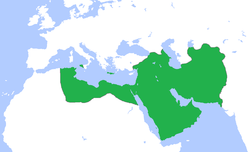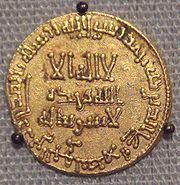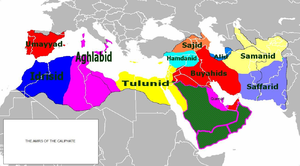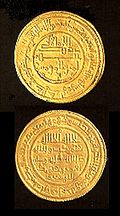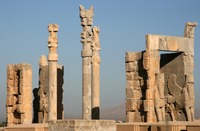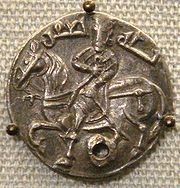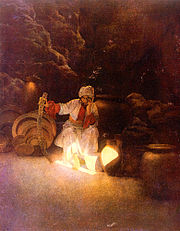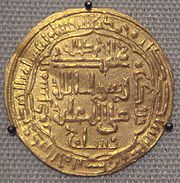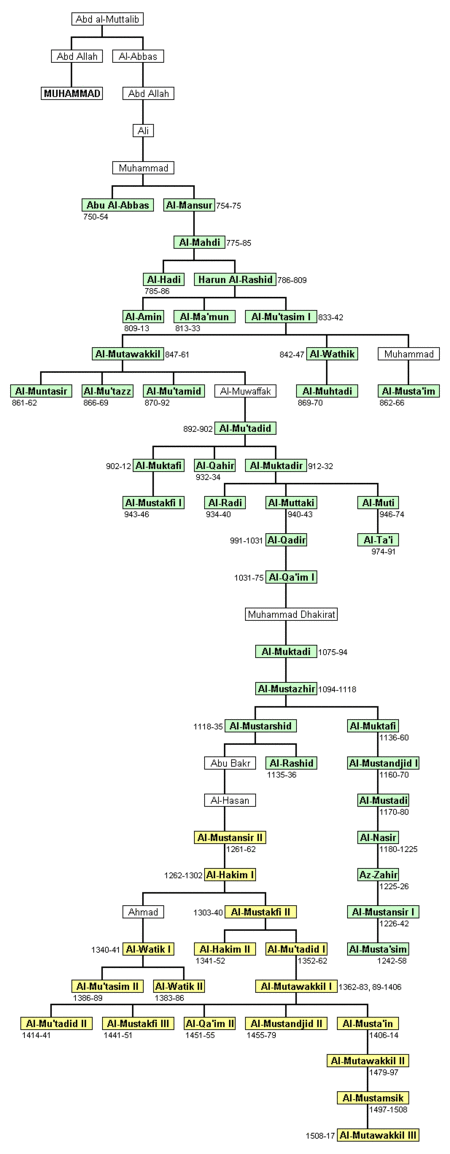
Abbasid Caliphate
Did you know...
This Schools selection was originally chosen by SOS Children for schools in the developing world without internet access. It is available as a intranet download. See http://www.soschildren.org/sponsor-a-child to find out about child sponsorship.
| Abbasid Caliphate الخلافة العباسية al-khilāfah al-‘abbāsīyyah |
|||||
|
|||||
|
Flag |
|||||
|
Abbasid Caliphate (green) at its greatest extent, c. 850.
|
|||||
| Capital | Baghdad | ||||
| Languages | Arabic (official), Aramaic, Armenian, Berber languages, Georgian, Greek, Hebrew, Middle Persian, Turkish, Kurdish | ||||
| Religion | Sunni Islam | ||||
| Government | Caliphate | ||||
| Amir al-Mu'minin¹ | |||||
| - | 721–754 | As-Saffah | |||
| - | 786–809 | Harun al-Rashid | |||
| - | 1261–1262 | Al-Mustansir | |||
| - | 1242–1258 | Al-Musta'sim | |||
| History | |||||
| - | Established | 750 | |||
| - | Disestablished | 1258 | |||
| Area | 10,000,000 km² (3,861,022 sq mi) | ||||
| Population | |||||
| - | est. | 50,000,000 | |||
| Density | 5 /km² (12.9 /sq mi) | ||||
| Currency | Abbasid Dinar | ||||
| Today part of | |||||
| ¹ Amir al-Mu'minin (أمير المؤمنين), Caliph (خليفة) | |||||
| Historical Arab states and dynasties | ||||||||||||||||||||||
|---|---|---|---|---|---|---|---|---|---|---|---|---|---|---|---|---|---|---|---|---|---|---|
|
Arab Caliphate
|
||||||||||||||||||||||
|
Mashriq Dynasties
|
||||||||||||||||||||||
|
Maghrib Dynasties
|
The Abbasid caliphate or, more simply, the Abbasids (Arabic: العبّاسيّون / ISO 233: al-‘abbāsīyūn), was the third of the Islamic caliphates. It was ruled by the Abbasid dynasty of caliphs, who built their capital in Baghdad after overthrowing the Umayyad caliphs from all but the Al Andalus region.
The Abbasid caliphate was founded by the descendants of the Islamic prophet Muhammad's youngest uncle, Abbas ibn Abd al-Muttalib, in Harran in 750 CE and shifted its capital in 762 to Baghdad. It flourished for two centuries, but slowly went into decline with the rise to power of the Turkish army it had created, the Mamluks. Within 150 years of gaining control of Persia, the caliphs were forced to cede power to local dynastic emirs who only nominally acknowledged their authority. The caliphate also lost the Western provinces of Al Andalus, Maghreb and Ifriqiya to an Umayyad prince, the Aghlabids and the Fatimids, respectively.
The Abbasids' rule was briefly ended for three years in 1258, when Hulagu Khan, the Mongol khan, sacked Baghdad, resuming in Mamluk Egypt in 1261, from where they continued to claim authority in religious matters until 1519, when power was formally transferred to the Ottomans and the capital relocated to Constantinople.
Rise
The Abbasid caliphs descended from Abbas ibn Abd al-Muttalib (566 – 662), one of the youngest uncles of Muhammad, because of which they considered themselves the true successor of Muhammad as opposed to the Umayyads. The Umayyads were descended from Umayya, and were a clan separate from Muhammad's in the Quraish tribe. They won the backing of Shiites (i.e. the Hashimiyya sub-sect of the Kaysanites Shia) against the Umayyads by temporarily converting to Shia Islam and joining their fight against Umayyad rule.
The Abbasids also distinguished themselves from the Umayyads by attacking their moral character and administration in general. According to Ira Lapidus, "The Abbasid revolt was supported largely by Arabs, mainly the aggrieved settlers of Marw with the addition of the Yemeni faction and their Mawali". The Abbasids also appealed to non-Arab Muslims, known as mawali, who remained outside the kinship-based society of the Arabs and were perceived as a lower class within the Umayyad empire. Muhammad ibn 'Ali, a great-grandson of Abbas, began to campaign for the return of power to the family of Muhammad, the Hashimites, in Persia during the reign of Umar II.
During the reign of Marwan II, this opposition culminated in the rebellion of Ibrahim the Imam, the fourth in descent from Abbas. Supported by the province of Khorasan, Iran, he achieved considerable success, but was captured in the year 747 and died in prison; some hold that he was assassinated. The quarrel was taken up by his brother Abdallah, known by the name of Abu al-'Abbas as-Saffah, who defeated the Umayyads in 750 in the Battle of the Zab near the Great Zab and was subsequently proclaimed caliph.
Immediately after their victory Abu al-'Abbas as-Saffah sent his forces to North Africa and Central Asia, where his forces fought against Tang expansion during the Battle of Talas (the Abbasids were known to their opponents as the: "Black robed ones"). Barmakids, who were instrumental in building Baghdad; introduced the world's first recorded paper mill in Baghdad, thus beginning a new era of intellectual rebirth in the Abbasid domain. Within 10 years the Abbasids built another renowned paper mill in the Umayyad capital of Córdoba in Spain.
Political situation
Consolidation and schisms
The first change the Abbasids made was to move the empire's capital from Damascus, in Syria, to Baghdad in Iraq. This was to both appease as well to be closer to the Persian mawali support base that existed in this region more influenced by Persian history and culture, and part of the Persian mawali demand for less Arab dominance in the empire. Baghdad was established on the Tigris River in 762. A new position, that of the vizier, was also established to delegate central authority, and even greater authority was delegated to local emirs. Eventually, this meant that many Abbasid caliphs were relegated to a more ceremonial role than under the Umayyads, as the viziers began to exert greater influence, and the role of the old Arab aristocracy was slowly replaced by a Persian bureaucracy.
The Abbasids had depended heavily on the support of Persians [see 'Abbasid Dynasty article in Britannica] in their overthrow of the Umayyads. Abu al-'Abbas' successor, Al-Mansur, moved their capital from Damascus to the new city of Baghdad and welcomed non-Arab Muslims to their court. While this helped integrate Arab and Persian cultures, it alienated many of their Arab supporters, particularly the Khorasanian Arabs who had supported them in their battles against the Umayyads.
These fissures in their support led to immediate problems. The Umayyads, while out of power, were not destroyed. The only surviving member of the Umayyad royal family, which had been all but annihilated, ultimately made his way to Spain where he established himself as an independent Emir ( Abd ar-Rahman I, 756). In 929, Abd ar-Rahman III assumed the title of Caliph, establishing Al Andalus from Córdoba as a rival to Baghdad as the legitimate capital of the Islamic Empire.
Rift with the Shia Muslims
| History of Iran | |||||||
|---|---|---|---|---|---|---|---|
| ANCIENT | |||||||
| Proto-Elamite 3200–2700 BCE | |||||||
| Elam 2700–539 BCE | |||||||
| Mannaeans 850–616 BCE | |||||||
| IMPERIAL | |||||||
| Median Empire 678–550 BCE | |||||||
| ( Scythian Kingdom 652–625 BCE) | |||||||
| Achaemenid Empire 550–330 BCE | |||||||
| Seleucid Empire 312–63 BCE | |||||||
| Parthian Empire 247 BCE – 224 CE | |||||||
| Sassanid Empire 224–651 | |||||||
| MIDDLE AGES | |||||||
| Umayyad Caliphate 661–750 | |||||||
| Abbasid Caliphate 750–1258 | |||||||
| Ziyarid Dynasty 928–1043 |
Saffarid Dynasty 867–1002 |
||||||
| Buyid Dynasty 934–1055 |
Samanid Dynasty 875–999 |
||||||
| Ghaznavid Empire 963–1186 | |||||||
| Great Seljuq Empire 1037–1194 | |||||||
| Khwarazmian Empire 1077–1231 | |||||||
| Ilkhanate Empire 1256–1335 | |||||||
| Chobanid Dynasty 1335–1357 |
Muzaffarid Dynasty 1335–1393 |
||||||
| Jalayirid Dynasty 1336–1432 |
Sarbadars 1337–1376 |
||||||
| Timurid Empire 1370–1405 | |||||||
| Qara Qoyunlu 1406–1468 |
Timurid Dynasty 1405–1507 |
||||||
| Agh Qoyunlu 1468–1508 |
|||||||
| EARLY MODERN | |||||||
| Safavid Empire 1501–1736 | |||||||
| ( Hotaki Dynasty 1722–1729) | |||||||
| Afsharid Empire 1736–1747 | |||||||
| Zand Dynasty 1760–1794 |
Afsharid Dynasty 1747–1796 |
||||||
| Qajar Empire 1796–1925 | |||||||
| MODERN | |||||||
| Pahlavi Dynasty 1925–1979 | |||||||
| Interim Government 1979–1980 | |||||||
| Islamic Republic 1980–present | |||||||
|
Related articles
Timeline of Iranian history |
|||||||
The Abbasids also found themselves at odds with the Shia Muslims, most of whom had supported their war against the Umayyads, since the Abbasids and the Shias claimed legitimacy by their familial connection to Muhammad. Once in power, the Abbasids embraced Sunni Islam and disavowed any support for Shi'a beliefs. That led to numerous conflicts, culminating in an uprising in Mecca in 786, followed by widespread bloodshed and the flight of many Shi'a to the Maghreb, where the survivors established the Idrisid kingdom. The Abbasids also executed the direct descendants of the Prophet Muhammad who were also the Shia Imams, which includes Imam Jafar Sadiq and other respected nobles. Shortly thereafter, Berber Kharijites set up an independent state in North Africa in 801. Within 50 years the Idrisids in the Maghreb and Aghlabids of Ifriqiya and a little later the Tulunids and Ikshidids of Misr were effectively independent in Africa.
Communication with provinces
The Abbasid leadership had to work hard in the last half of the eighth century (750–800), under several competent caliphs and their viziers to overcome the political challenges created by the far flung nature of the empire, and the limited communication across it and usher in the administrative changes to keep order. While the Byzantine Empire was fighting Abbasid rule in Syria and Anatolia, military operations during this period were minimal, as the caliphate focused on internal matters as local governors, who, as a matter of procedure, operated mostly independently of central authority. The problem that the caliphs faced was that these governors had begun to exert greater autonomy, using their increasing power to make their positions hereditary.
At the same time, the Abbasids faced challenges closer to home. Former supporters of the Abbasids had broken away to create a separate kingdom around Khorosan in northern Persia. Harun al-Rashid (786 – 809) turned on the Barmakids, a Persian family that had grown significantly in power within the administration of the state and killed most of the family. During the same period, several factions, or opposing groups, began either to leave the empire for other lands or to take control of distant parts of the empire away from the Abbasids.
Golden Age
"Arab Muslims now studied astronomy, alchemy, medicine and mathematics with such success that, during the ninth and tenth centuries, more scientific discoveries had been achieved in the Abbasid empire than in any previous period of history."— Karen Armstrong
The Islamic Golden Age was inaugurated by the middle of the 8th century by the ascension of the Abbasid Caliphate and the transfer of the capital from Damascus to Baghdad. The Abbassids were influenced by the Qur'anic injunctions and hadith such as "the ink of a scholar is more holy than the blood of a martyr" stressing the value of knowledge. During this period the Muslim world became the unrivaled intellectual centre for science, philosophy, medicine and education as the Abbasids championed the cause of knowledge and established the House of Wisdom in Baghdad; where both Muslim and non-Muslim scholars sought to translate and gather all the world's knowledge into Arabic. Many classic works of antiquity that would otherwise have been lost were translated into Arabic and Persian and later in turn translated into Turkish, Hebrew and Latin. During this period the Muslim world was a cauldron of cultures which collected, synthesized and significantly advanced the knowledge gained from the ancient Roman, Chinese, Indian, Persian, Egyptian, North African, Greek and Byzantine civilizations.
Science
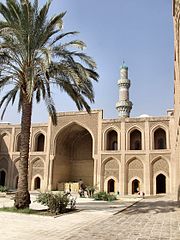
The reigns of Harun al-Rashid (786 – 809) and his successors fostered an age of great intellectual achievement. In large part, this was the result of the schismatic forces that had undermined the Umayyad regime, which relied on the assertion of the superiority of Arab culture as part of its claim to legitimacy, and the Abbasids' welcoming of support from non-Arab Muslims. It is well established that the Abbasid caliphs modeled their administration on that of the Sassanids. Harun al-Rashid's son, Al-Ma'mun (whose mother was Persian), is even quoted as saying:
- "The Persians ruled for a thousand years and did not need us Arabs even for a day. We have been ruling them for one or two centuries and cannot do without them for an hour."
A number of medieval thinkers and scientists living under Islamic rule played a role in transmitting Islamic science to the Christian West. They contributed to making Aristotle known in Christian Europe. In addition, the period saw the recovery of much of the Alexandrian mathematical, geometric and astronomical knowledge, such as that of Euclid and Claudius Ptolemy. These recovered mathematical methods were later enhanced and developed much further by other Islamic scholars, notably by Persian scientists Al-Biruni and Abu Nasr Mansur.
Algebra was also pioneered by Persian Scientist Muhammad ibn Mūsā al-Khwārizmī during this time in his landmark text, Kitab al-Jabr wa-l-Muqabala, from which the term algebra is derived. He is thus considered to be the father of algebra. The terms algorism and algorithm are also derived from the name of al-Khwarizmi, who was responsible for introducing the Arabic numerals and Hindu-Arabic numeral system beyond the Indian subcontinent.
Ibn al-Haytham (Alhazen) developed an early scientific method in his Book of Optics (1021). The most important development of the scientific method was the use of experiments to distinguish between competing scientific theories set within a generally empirical orientation, which began among Muslim scientists. Ibn al-Haytham is also regarded as the father of optics, especially for his empirical proof of the intromission theory of light. Bradley Steffens described Ibn al-Haytham as the "first scientist" for his development of scientific method.
Medicine in medieval Islam was an area of science that advanced particularly during the Abbasids' reign. During the ninth century, Baghdad contained over 800 doctors, and great discoveries in the understanding of anatomy and diseases were made. The clinical distinction between measles and smallpox was discovered during this time. Famous Persian scientist Ibn Sina (known to the West as Avicenna) produced treatises and works that summarized the vast amount of knowledge that scientists had accumulated, and is often known as the father of modern medicine for his encyclopedias, The Canon of Medicine and The Book of Healing. The work of him and many others directly influenced the research of European scientists during the Renaissance and even later.
Astronomy in medieval Islam was advanced by Al-Battani, who improved the precision of the measurement of the precession of the Earth's axis. The corrections made to the geocentric model by al-Battani, Averroes, Nasir al-Din al-Tusi, Mo'ayyeduddin Urdi and Ibn al-Shatir were later incorporated into the Copernican heliocentric model. The astrolabe, though originally developed by the Greeks, was perfected by Islamic astronomers and engineers, and was subsequently brought to Europe.
Muslim chemists and alchemists played an important role in the foundation of modern chemistry. Scholars such as Will Durant and Alexander von Humboldt regard Muslim chemists to be the founders of chemistry. In particular, Jābir ibn Hayyān (Geber) is considered the "father of chemistry". The works of Arab chemists influenced Roger Bacon (who introduced the empirical method to Europe, strongly influenced by his reading of Arabic writers), Isaac Newton, among many others. A number of chemical processes such as distillation techniques and the production of alcohol were developed in the Muslim world and then spread to Europe.
Literature
The most well known fiction from the Islamic world was The Book of One Thousand and One Nights (Arabian Nights). The original concept is derived from pre-Islamic Iranian (Persian) prototype with reliance on Indian elements. It also includes stories from the rest of the Middle-Eastern and North African nations. The epic took form in the 10th century and reached its final form by the 14th century; the number and type of tales have varied from one manuscript to another. All Arabian fantasy tales were often called "Arabian Nights" when translated into English, regardless of whether they appeared in The Book of One Thousand and One Nights. This epic has been influential in the West since it was translated in the 18th century, first by Antoine Galland. Many imitations were written, especially in France. Various characters from this epic have themselves become cultural icons in Western culture, such as Aladdin, Sinbad and Ali Baba.
A famous example of Persian poetry on romance is Layla and Majnun, dating back to the Umayyad era in the 7th century. It is a tragic story of undying love much like the later Romeo and Juliet, which was itself said to have been inspired by a Latin version of Layli and Majnun to an extent.
Arabic poetry reached its greatest heights in the Abbasid era, especially before the loss of central authority and the rise of the Persianate dynasties. Writers like Abu Tammam and Abu Nuwas were closely connected to the caliphal court in Baghdad during the early 9th century, while others such as al-Mutanabbi received their patronage from regional courts.
Philosophy
One of the common definitions for "Islamic philosophy" is "the style of philosophy produced within the framework of Islamic culture." Islamic philosophy, in this definition is neither necessarily concerned with religious issues, nor is exclusively produced by Muslims. Their works on Aristotle was a key step in the transmission of learning from ancient Greeks to the Islamic world and the West. They often corrected the philosopher, encouraging a lively debate in the spirit of ijtihad. They also wrote influential original philosophical works, and their thinking was incorporated into Christian philosophy during the Middle Ages, notably by Thomas Aquinas.
Three speculative thinkers, al-Kindi, al-Farabi, and Avicenna, combined Aristotelianism and Neoplatonism with other ideas introduced through Islam, and Avicennism was later established as a result. Other influential Muslim philosophers in the Caliphates include al-Jahiz, a pioneer in evolutionary thought, and Ibn al-Haytham (Alhacen), a pioneer of phenomenology and the philosophy of science and a critic of Aristotelian physics and Aristotle's concept of place ( topos).
Technology
In technology, the Muslim world adopted papermaking from China. The knowledge of gunpowder was also transmitted from China via Islamic countries, where the formulas for pure potassium nitrate and an explosive gunpowder effect were first developed.
Advances were made in irrigation and farming, using new technology such as the windmill. Crops such as almonds and citrus fruit were brought to Europe through al-Andalus, and sugar cultivation was gradually adopted by the Europeans. Arab merchants dominated trade in the Indian Ocean until the arrival of the Portuguese in the 16th century. Hormuz was an important centre for this trade. There was also a dense network of trade routes in the Mediterranean, along which Muslim countries traded with each other and with European powers such as Venice, Genoa and Catalonia. The Silk Road crossing Central Asia passed through Muslim states between China and Europe.
Muslim engineers in the Islamic world made a number of innovative industrial uses of hydropower, and early industrial uses of tidal power, wind power, steam power, fossil fuels such as petroleum, and early large factory complexes (tiraz in Arabic). The industrial uses of watermills in the Islamic world date back to the 7th century, while horizontal- wheeled and vertical-wheeled water mills were both in widespread use since at least the 9th century. A variety of industrial mills were being employed in the Islamic world, including early fulling mills, gristmills, hullers, sawmills, shipmills, stamp mills, steel mills, sugar mills, tide mills and windmills. By the 11th century, every province throughout the Islamic world had these industrial mills in operation, from al-Andalus and North Africa to the Middle East and Central Asia. Muslim engineers also invented crankshafts and water turbines, employed gears in mills and water-raising machines, and pioneered the use of dams as a source of water power, used to provide additional power to watermills and water-raising machines. Such advances made it possible for many industrial tasks that were previously driven by manual labour in ancient times to be mechanized and driven by machinery instead in the medieval Islamic world.
A number of industries were generated during the Arab Agricultural Revolution, including early industries for astronomical instruments, ceramics, chemicals, distillation technologies, clocks, glass, mechanical hydropowered and wind powered machinery, matting, mosaics, pulp and paper, perfumery, petroleum, pharmaceuticals, rope-making, shipping, shipbuilding, silk, sugar, textiles, water, weapons, and the mining of minerals such as sulfur, ammonia, lead and iron. Early factories (tiraz) were built for many industries, and knowledge of these industries were later transmitted to medieval Europe, especially during the Latin translations of the 12th century. For example, the first glass factories in Europe were founded in the 11th century by Egyptian craftsmen in Greece. The agricultural and handicraft industries also experienced high levels of growth during this period.
Fracture of central authority
The Loss of Power to Autonomous Dynasties
Even by 820, the Samanids had begun the process of exercising independent authority in Transoxiana and Greater Khorasan, as had the Shia Hamdanids in Northern Syria, and the succeeding Tahirid and Saffarid dynasties of Iran. By the early 10th century, the Abbasids almost lost control of Iraq to various amirs, and the caliph al-Radi was forced to acknowledge their power by creating the position of "Prince of Princes" (amir al-umara). Shortly thereafter, the Persian faction known as the Buwayhids from Daylam swept into power and assumed control over the bureaucracy in Baghdad. According to the history of Miskawayh, they began distributing iqtas ( fiefs in the form of tax farms) to their supporters.
Outside Iraq, all the autonomous provinces slowly took on the characteristic of de facto states with hereditary rulers, armies, and revenues and operated under only nominal caliph suzerainty, which may not necessarily be reflected by any contribution to the treasury, such as the Soomro Emirs that had gained control of Sindh and ruled the entire province from their capital of Mansura. Mahmud of Ghazni took the title of sultan, as opposed to the "amir" that had been in more common usage, signifying the Ghaznavid Empire's independence from caliphal authority, despite Mahmud's ostentatious displays of Sunni orthodoxy and ritual submission to the caliph. In the 11th century, the loss of respect for the caliphs continued, as some Islamic rulers no longer mentioned the caliph's name in the Friday khutba, or struck it off their coinage.
The Ismaili Fatimid dynasty of Cairo contested the Abbasids for even the titular authority of the Islamic ummah. They commanded some support in the Shia sections of Baghdad (such as Karkh), although Baghdad was the city most closely connected to the caliphate, even in the Buwayhid and Saljuq eras. The Fatimids' white banners contrasted with Abbasids' black, and the challenge of the Fatimids only ended with their downfall in the 12th century.
Despite the power of the Buwayhid amirs, the Abbasids retained a highly ritualized court in Baghdad, as described by the Buwayhid bureaucrat Hilal al-Sabi', and they retained a certain influence over Baghdad as well as religious life. As Buwayhid power waned after the death of Baha' al-Daula, the caliphate was able to regain some measure of strength. The caliph al-Qadir, for example, led the ideological struggle against the Shia with writings such as the Baghdad Manifesto. The caliphs kept order in Baghdad itself, attempting to prevent the outbreak of fitna s in the capital, often contending with the ayyarun.
Abbasid Relations with the Saljuq Dynasty
With the Buwayhid dynasty on the wane, a vacuum was created that was eventually filled by the dynasty of Oghuz Turks known as the Saljuqs. When the amir and former slave Basasiri took up the Shia Fatimid banner in Baghdad in 1058, the caliph al-Qa'im was unable to defeat him without outside help. Toghril Beg, the Saljuq sultan, restored Baghdad to Sunni rule and took Iraq for his dynasty. Once again, the Abbasids were forced to deal with a military power that they could not match, though the Abbasid caliph remained the titular head of the Islamic community. The succeeding sultans Alp Arslan and Malikshah, as well as their vizier Nizam al-Mulk took up residence in Persia, but held power over the Abbasids in Baghdad. When the dynasty began to weaken in the 12th century, the Abbasids gained greater independence once again.
Late Revival of Military Strength, 1118-1258
While the Caliph al-Mustarshid was the first caliph to build an army capable of meeting a Saljuq army in battle, he was nonetheless defeated in 1135 and assassinated. The Caliph al-Muqtafi was the first Abbasid Caliph to regain the full military independence of the Caliphate, with the help of his vizier Ibn Hubayra. After nearly 250 years of subjection to foreign dynasties, he successfully defended Baghdad against the Saljuqs in the siege of Baghdad (1157), thus securing Iraq for the Abbasids. The reign of al-Nasir (d. 1225) brought the caliphate to power throughout Iraq, based in large part on the Sufi futuwwa organizations that the caliph headed. Al-Mustansir built the Mustansiriya School, in an attempt to eclipse the Saljuq-era Nizamiyya built by Nizam al-Mulk.
The end of the dynasty
Hulagu Khan sacked Baghdad on February 10, 1258, causing great loss of life. Muslims feared that a supernatural disaster would strike if the blood of Al-Musta'sim, a direct descendant of Muhammad's uncle and the last reigning Abbasid caliph in Baghdad, was spilled. The Learned Shiites of Persia stated that no such calamity had happened after the deaths of the Shiite Imam (leader) Hussein; nevertheless, as a precaution and in accordance with a Mongol taboo which forbade spilling royal blood, Hulagu had Al-Musta'sim wrapped in a carpet and trampled to death by horses on February 20, 1258. The Al-Musta'sim family was also executed, with the lone exceptions of his youngest son who was sent to Mongolia, and a daughter who became a slave in the harem of Hulagu. According to Mongolian historians, the surviving son married and fathered children.
The Abbasids continued to maintain the presence of authority, yet it was confined to religious matters in Egypt, under the Mamluks. The dynasty finally ended with Al-Mutawakkil III, who was taken away as a prisoner, by Selim I, to Constantinople where he had a ceremonial role until his death in 1543.
Role of the Mamluks
In the 9th century, the Abbasids created an army loyal only to their caliphate, drawn mostly from Turkish slaves, known as Mamluks, with some Slavs and Berbers participating as well. This force, created in the reign of al-Ma'mun (813 – 833), and his brother and successor al-Mu'tasim (833 – 842), prevented the further disintegration of the empire.
The Mamluk army, though often viewed negatively, both helped and hurt the caliphate. Early on, it provided the government with a stable force to address domestic and foreign problems. However, creation of this foreign army and al-Mu'tasim's transfer of the capital from Baghdad to Samarra created a division between the caliphate and the peoples they claimed to rule. In addition, the power of the Mamluks steadily grew until al-Radi (934 – 941) was constrained to hand over most of the royal functions to Mahommed bin Raik. In the following years, the Buwayhids, who were Shi'ites, seized power over Baghdad, ruling central Iraq for more than a century.
List of Abbasid Caliphs
- Abu'l Abbas As-Saffah 750 – 754
Abbasid Caliphs in Baghdad
- Al-Mansur 754 – 775
- Al-Mahdi 775 – 785
- Al-Hadi 785 – 786
- Harun al-Rashid 786 – 809
- Al-Amin 809 – 813
- Al-Ma'mun 813 – 833
- Al-Mu'tasim 833 – 842
- Al-Wathiq 842 – 847
- Al-Mutawakkil 847 – 861
- Al-Muntasir 861 – 862
- Al-Musta'in 862 – 866
- Al-Mu'tazz 866 – 869
- Al-Muhtadi 869 – 870
- Al-Mu'tamid 870 – 892
- Al-Mu'tadid 892 – 902
- Al-Muktafi 902 – 908
- Al-Muqtadir 908 – 932
- Al-Qahir 932 – 934
- Ar-Radi 934 – 940
- Al-Muttaqi 940 – 944
- Al-Mustakfi 944 – 946
- Al-Muti 946 – 974
- At-Ta'i 974 – 991
- Al-Qadir 991 – 1031
- Al-Qa'im 1031–1075
- Al-Muqtadi 1075–1094
- Al-Mustazhir 1094–1118
- Al-Mustarshid 1118–1135
- Ar-Rashid 1135–1136
- Al-Muqtafi 1136–1160
- Al-Mustanjid 1160–1170
- Al-Mustadi 1170–1180
- An-Nasir 1180–1225
- Az-Zahir 1225–1226
- Al-Mustansir 1226–1242
- Al-Musta'sim 1242–1258
Abbasid Caliphs in Cairo
- Al-Mustansir 1261–1262
- Al-Hakim I (Cairo) 1262–1302
- Al-Mustakfi I of Cairo 1303–1340
- Al-Wathiq I 1340–1341
- Al-Hakim II 1341–1352
- Al-Mu'tadid I 1352–1362
- Al-Mutawakkil I 1362–1383
- Al-Wathiq II 1383–1386
- Al-Mu'tasim 1386–1389
- Al-Mutawakkil I (restored) 1389–1406
- Al-Musta'in 1406–1414
- Al-Mu'tadid II 1414–1441
- Al-Mustakfi II 1441–1451
- Al-Qa'im 1451–1455
- Al-Mustanjid 1455–1479
- Al-Mutawakkil II 1479–1497
- Al-Mustamsik 1497–1508
- Al-Mutawakkil III 1508–1517

